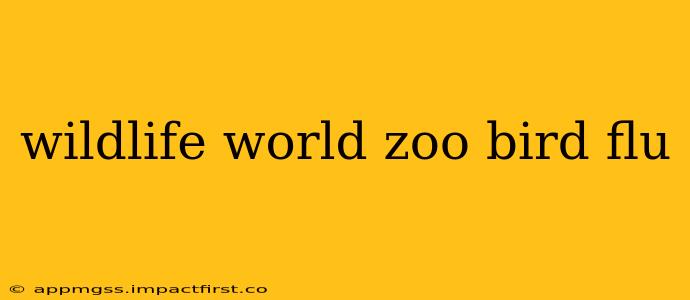The recent outbreaks of highly pathogenic avian influenza (HPAI), commonly known as bird flu, have raised significant concerns worldwide, including within the zoological community. Wildlife World Zoo, like many other zoos and wildlife parks, faces unique challenges in protecting its avian collection and mitigating the risk of outbreaks. This article delves into the impact of bird flu on Wildlife World Zoo and similar institutions, exploring preventative measures, containment strategies, and the broader implications for wildlife conservation.
What is Avian Influenza (Bird Flu)?
Avian influenza is a viral infection affecting birds. While many strains are relatively harmless, highly pathogenic avian influenza viruses (HPAIs) can cause severe illness and high mortality rates in poultry and wild birds. These HPAIs can also pose a risk to humans, although direct transmission from birds to humans is relatively rare. The current HPAI outbreaks are primarily driven by H5N1 strains. Understanding the nature of this virus is crucial in implementing effective control measures.
How Does Bird Flu Affect Zoos Like Wildlife World Zoo?
Zoos, with their diverse collections of birds, are particularly vulnerable to avian influenza outbreaks. The close proximity of birds, combined with the potential for contact with migratory birds, creates a high-risk environment. An outbreak at Wildlife World Zoo or a similar facility could lead to significant losses within their avian populations, impacting conservation efforts and public engagement programs. The economic impact of an outbreak can also be substantial, considering the costs associated with quarantine, disinfection, and potential veterinary care.
What Measures Does Wildlife World Zoo (and Other Zoos) Take to Prevent Bird Flu?
Wildlife World Zoo, like many responsible zoos, implements stringent biosecurity measures to mitigate the risk of avian influenza. These include:
- Strict hygiene protocols: Regular disinfection of enclosures, equipment, and staff attire.
- Restricted access: Limiting access to bird enclosures to authorized personnel only.
- Surveillance and monitoring: Closely monitoring the health of birds for any signs of illness.
- Quarantine procedures: Isolating any birds showing signs of illness to prevent the spread of the virus.
- Vaccination (where appropriate): Some zoos may utilize vaccination programs for susceptible species, though this is dependent on vaccine availability and effectiveness against circulating strains.
- Biosecurity training for staff: Ongoing training for zoo staff on proper biosecurity protocols.
What Happens if Bird Flu is Detected at Wildlife World Zoo?
In the event of a suspected or confirmed bird flu case at Wildlife World Zoo, a rapid response plan would be activated. This plan would likely involve:
- Immediate quarantine: Isolating affected birds and potentially the entire avian collection.
- Notification of authorities: Reporting the suspected outbreak to relevant animal health authorities.
- Depopulation (in severe cases): In some circumstances, the difficult decision to euthanize infected birds may be necessary to prevent the spread of the virus. This is a last resort and is always done humanely.
- Disinfection and decontamination: Thorough cleaning and disinfection of affected areas.
Can Bird Flu Spread from Zoo Birds to Humans?
While the risk of human infection from zoo birds is low, it's not zero. The virus can spread through direct contact with infected birds or their droppings. Zoos typically have safety protocols in place to minimize this risk, including staff training on proper hygiene and protective equipment. However, it's important to remember that maintaining a safe distance from birds, especially those exhibiting signs of illness, is crucial.
What Role Do Zoos Play in Avian Influenza Research and Conservation?
Zoos play a crucial role in avian influenza research and conservation. They provide valuable opportunities for studying the virus and developing effective preventative measures. Furthermore, many zoos participate in breeding programs for endangered species, ensuring the preservation of genetic diversity and contributing to conservation efforts even during outbreaks.
How Can I Support Zoos During Bird Flu Outbreaks?
Supporting zoos during bird flu outbreaks is crucial. This includes following their guidelines regarding biosecurity, staying informed about any restrictions or closures, and making donations to help them cover the increased costs associated with managing the outbreak. Your support helps ensure that zoos can continue their vital conservation work.
This comprehensive look at the impact of bird flu on Wildlife World Zoo and the wider zoological community highlights the importance of proactive biosecurity measures and collaborative efforts in mitigating the risk of outbreaks and protecting avian populations. The dedication of zoo professionals to animal welfare and conservation shines through in their response to such challenges.
